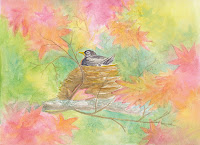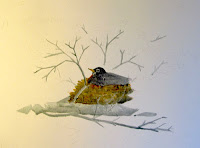I wanted brighter colors and I liked how the background leaves turned out, but adding so many bright leaves in the background distracted from the rather dark and uninteresting Robin in the second painting. It was time for a third painting. Before doing the painting I studied Robins and worked on getting the pose of the Robin sitting in the nest. I decided to eliminate a few more branches and also to make the nest the full height (as it was in the first painting). I painted the Robin, nest and branches first, but did not mask them. I then uses the same wet-on-wet technique that I used in the second painting to add in the background, but with fewer distinct leaves. Unfortunately there was a flaw in the paper that only appeared after I had started painting the wet-on-wet background. I finished the painting anyway, knowing a fourth painting would be needed.
Picking up a pencil, pen and brush again. Trying new techniques and maybe developing my own style.
Saturday, July 27, 2013
Saturday, July 20, 2013
Project Robin: second painting
The small branches in front of the Robin and the seeds in the first painting were distracting, and the colors were not bright enough in some areas of the painting. Also the nest seemed to sit on top of the branch, instead of behind it. I quickly decided to do a second painting removing the seeds, some of the branches and making the nest shorter. To brighten the colors I decided to use the method I learned from Margaret Walsh Best. I painted the Robin, nest and a few branches first, masked them.
The wet-on-wet background was added in two layers, the first was Phthalocyanine Blue and Lemon Yellow and the second was Quinacridone Rose and Cadmium Yellow. Finally I added a few leaf shapes. When I removed the masking from the Robin and nest it removed some of the paint and raised the paper. When I added paint back the paper quickly absorbed it making it difficult to control how the paint spread.
Sunday, July 14, 2013
Project Robin: first painting
I've been working on a painting of a Robin for a friend's birthday. It is based on a photo I took of a nesting Robin in our Japanese Red Maple tree (Acer palmatum atropurpureum). I noticed the Robin's nest while using the scope to watch the Bluebirds in the Martin House. I was looking through the branches of the Red Maple at the Martin House. The Red Maple is a beautiful tree, it leafs out red and as the leaves mature they slowly change to green. The progression of red to orange to yellow to green can be seen on each leaf like a reverse of fall coloration. The Robins had made a large twig nest in the lichen covered branches of the tree, and it was framed by the multi-colored leaves of the Red Maple.
I began working on the Robin project about a month ago. In that time I have done four paintings. Each painting has its good points, and each was done slightly differently in an effort to improve what I didn't like in the previous painting (more on those later). The one thing they all have in common is a palette of Quinacridone Rose, Phthalocyanine Blue, Cadmium Yellow and Lemon Yellow.
For the first painting I used the poured watercolors method I learned from Kie Johnson during a workshop earlier this year. First I masked the Robin, nest, seeds and branches. Then I poured Quinacridone Rose and Cadmium Yellow on the paper for the first layer. After the paint dried I poured a second layer of Phthalocyanine Blue and Lemon Yellow.
After the second layer dried I removed the masking and painted the Robin, nest, seeds and branches. I used a bit of Yellow Ochre and Burnt Umber in the nest and branches. I also added a few suggestions of leaves to the background.
Saturday, July 6, 2013
Trial garden
As the weather gets warmer plants and flowers fade in the heat. One place that always has beautiful flowers throughout the summer is the UGA Trial Garden. They specialize in plants that can handle the heat and product numerous blooms with vibrant colors. Since many of the plants are new cultivars you never know what you will find.

While walking through the garden the blooms of the Mexican Flame Vine (Pseudogynoxys chenopodioides) caught my eye. By the end of summer the vines will overgrow the arch it is planted on, but right now it is just wast high and covered in vibrant orange-red clusters blooms.
The flower's orange petals open to display a bright yellow center. As the flower ages it darkens to a deep red, and the yellow styles become a tangle of red fibers. There is another reason to grow this vine. The beautiful flowers attract butterflies and humming birds, which feed on the nectar.

While walking through the garden the blooms of the Mexican Flame Vine (Pseudogynoxys chenopodioides) caught my eye. By the end of summer the vines will overgrow the arch it is planted on, but right now it is just wast high and covered in vibrant orange-red clusters blooms.
The flower's orange petals open to display a bright yellow center. As the flower ages it darkens to a deep red, and the yellow styles become a tangle of red fibers. There is another reason to grow this vine. The beautiful flowers attract butterflies and humming birds, which feed on the nectar.
Subscribe to:
Posts (Atom)





